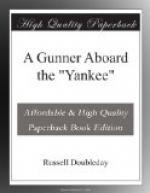“It’s an English tramp from the looks of her,” reported “Hay,” who had a choice position near the gun port. “She’s got a dozen people on the bridge and they are badly scared.”
A blank six-pounder was fired, but she did not heed it, so a shot was fired across the stranger’s bows, and she hove-to in short order.
“Steamer ahoy!” came faintly to our ears from on deck. “What steamer is that?”
The answer reached us in disjointed sentences, but we heard enough to set us laughing. Tommy smacked his hand upon the breech of the gun and chuckled: “It’s one of those everlasting press boats. The sea is full of ’em.”
“What in the deuce did they run for, I wonder?” exclaimed Kennedy.
“Afraid of us, I suppose. It’s ticklish times around here, and I don’t blame them. Press boats are not made to fight, you know.”
“That idea doesn’t carry out their motto,” drawled “Dye.”
“How’s that?” asked Flagg, innocently.
“Why, they claim that the pen is mightier than the sword, don’t they?”
After the laugh had subsided, “Morrie,” one of the Rochester detail, who acted as a shellman in the crew of Number Eight, said seriously:
“I am a great admirer of the press representatives down here, fellows. They are capable, good writers, and there is not a branch of the whole outfit that has been more faithful to duty. They were sent here to get the news, and they get it every time. There has never been a war more ably reported than this, and, although the correspondents have to hustle day and night, they still find time to keep us informed, and to give us an occasional paper from home. They are good fellows all.”
“Amen!” said “Hay.”
After a time, the press boat sheered off, and we continued on our course. Later in the morning another steamer was sighted. The “Yankee” was sent after her at full speed. The chase crowded on all steam, but she was soon overhauled, and found to be a Norwegian trader. After a satisfactory explanation she was permitted to go. Three hours later the “Yankee” dropped anchor off Mole St. Nicholas, a Haytian seaport brought into some prominence through the location of a cable station.
Mole St. Nicholas is a little collection of tropical-looking houses set among palm trees at the foot of a large hill, which in places aspires to the dignity of a mountain. The town itself is rather picturesquely situated, the foliage-covered background and beautiful inlet of pure clear water giving it a natural setting very attractive to our eyes.
After we had been anchored an hour or so, a bumboat came out, manned by a crew of two coal-black negroes who spoke a French patois, intermingled with comical English. The boat itself was a queer, stubby craft propelled by home-made oars. Before the morning was well advanced the ship was surrounded by boats carrying shells, limes, prickly pears, green cocoanuts, bananas, fish, and “water monkeys.” The latter were jugs made of a porous clay, and they were eagerly purchased. The “water monkey” is a natural cooler, and when placed in a draught of air will keep water at a temperature delightful in a warm latitude.




